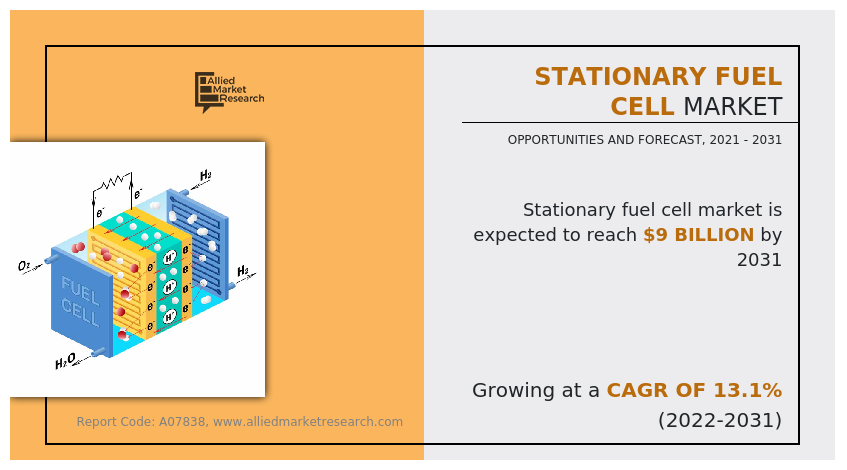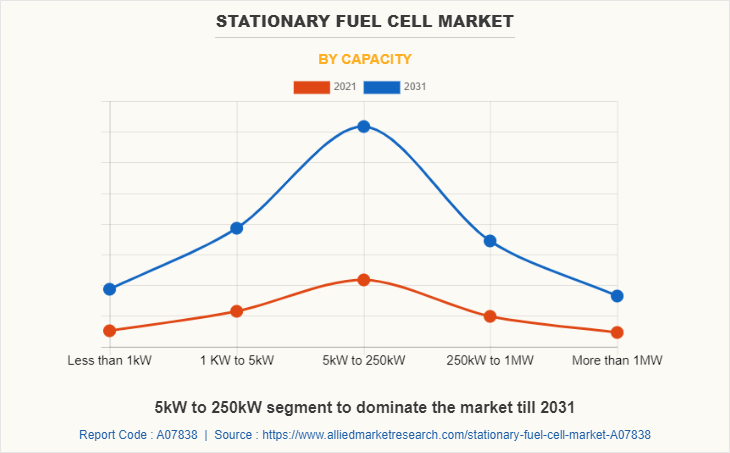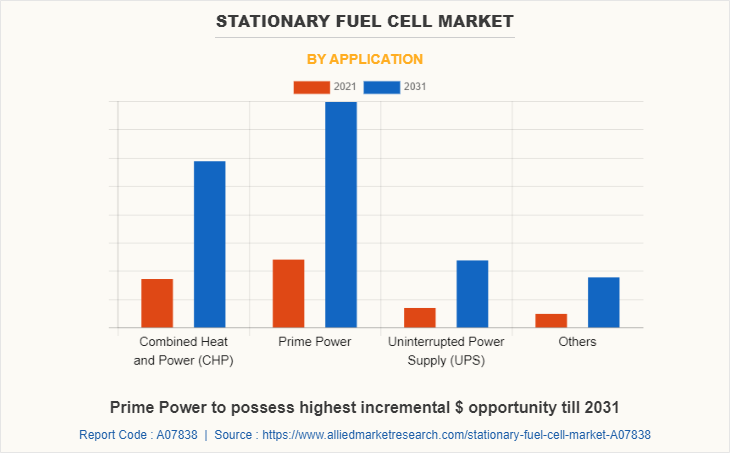Stationary Fuel Cell Market Overview
The global stationary fuel cell market size was valued at USD 2.6 billion in 2021, and stationary fuel cell industry is projected to reach USD 9.0 billion by 2031, growing at a CAGR of 13.1% from 2022 to 2031.
The rise in demand for clean power generation for the transport and power sectors is a key factor expected to drive the growth of the global fuel cell market during the forecast period. In addition, increase in distributed power system and high efficiency of fuel cells than other power generating systems are expected to significantly contribute toward the growth of the global fuel cell market from 2021 to 2030.

However, high cost of fuel cell systems and lack of hydrogen infrastructure are expected to hamper the growth of the market. Conversely, technological advancements in fuel cells, such as flexibility & improving operational efficiency, and rapid investment toward R&D of fuel cell systems, are expected to create potential growth opportunities for the key players operating in this market.
Introduction
A stationary fuel cell or fuel cell is a device that converts chemical energy into electrical energy through a chemical reaction of positively charged oxygen with hydrogen ions or another oxidizing agent.
Fuel cells are different from batteries, as they require a sustainable source of fuel and oxygen or air to continue the chemical reaction. Fuel cells produce electricity continuously for a long time as sustainable sources of fuels, such as hydrogen, phosphoric acid, and other electrolytes are supplied. Fuel cells have higher efficiency than gas or diesel engines. Fuel cells operate silently, as compared to other engines. They are, therefore, used within buildings, such as hospitals and others.
Report Key Highlighters
- The stationary fuel cell market has been analyzed in value. The value of the stationary fuel cell market is analyzed in millions.
- The stationary fuel cell market has been analyzed for more than 15 countries and profiled more than 10 company profiles across the globe.
- The stationary fuel cell market also provides analysis related to key regulations, pricing, and value chain.
- The stationary fuel cell market report also provides a competitive heatmap related to the product portfolio, product mapping, and positioning of top players.
- Key strategies such as product launches, acquisitions, mergers, expansion, and others are being pursued by manufacturers of stationary fuel cells are reported in this market report.
- Primary interviews with suppliers, wholesalers, suppliers, and manufacturers to understand market trends were conducted to better understand the various components of the market and its structure such as growth factors, pricing, and competitive strategies.
Top Impacting Factors
Rapid Adoption is Likely to Transform the Overall Industry
Stationary fuel cells are currently commonly used as an alternative to combustion heat engines for producing electrical power. Stationary fuel cell systems are very dependable systems that deliver excellent power quality and system efficiency when compared to combustion engines.
Furthermore, unlike a combustion engine, the stationary fuel cell system does not lose heat by utilizing it to its benefit. Such considerations are propelling the deployment of stationary fuel cell devices. Furthermore, because of their low noise level, stationary fuel cell devices are very versatile. Since they are incredibly quiet and emit very little pollution, these systems may be deployed anywhere.
Furthermore, as compared to any other energy-generating device, stationary fuel cells occupy an extremely little area. Stationary fuel cell systems may be directly linked to natural gas infrastructure, allowing them to generate power even in the absence of grid electricity. When compared to typical power generation methods, these fuel cells provide exceptionally high efficacy by producing nearly no emissions. Thus, the market adoption of stationary fuel cell systems is being driven by their great flexibility, efficiency, and other environmental benefits.
Development of renewable energy
The Paris Agreement, which was signed by the governments of several nations, aims to strengthen the parties' capacity to adapt to the consequences of climate change, mobilize adequate funding, and encourage each nation to decide, plan, and periodically report on its commitment to climate-friendly activities to slow global warming. Due to the increased need for alternative and clean energy sources, both emerging and developed nations are being prompted to raise money and support national and international environmental projects aimed at reducing global emissions.
Additionally, the market will benefit from the growing investments made by the key industry players in the creation of several cutting-edge technologies to boost the effectiveness of fuel cells. Thus, the development of renewable energy from wind and hydropower will drive the demand for energy storage devices which will offer lucrative opportunities for the stationary fuel cell market growth.
Segment Overview
The stationary fuel cell market forecast is segmented on the basis of capacity, type, application, end-use industry, and country. By capacity, the market is divided into less than 1 KW, 1 KW to 5 KW, 5 KW to 250 KW, 250 to 1 MW, and more than 1 MW. By type, the stationary fuel cell market is divided into Proton Exchange Membrane Fuel Cell (PEMFC), Phosphoric Acid Fuel Cell (PAFC), Molten Carbonate Fuel Cell (MCFC), Solid Oxide Fuel Cell (SOFC), Direct Methanol Fuel Cell (DMFC), and other. By application, the stationary fuel cell market is divided into combined heat and power, prime power, uninterrupted power supply, and others. On the basis of the end-use industry, the stationary fuel cell market is divided into transportation, defense, oil and gas, utilities, and others. Region-wise, it is analyzed across North America, Europe, Asia-Pacific and LAMEA.

On the basis of capacity, the 5KW to 250 KW segment accounted for 42.0% of the stationary fuel cell market share in 2021 and is expected to maintain its dominance during the forecast period. This is owing to its wide range of applications in large-scale industries such as chemical, petroleum, and others. Stationary fuel cells are widely used in combined heat and power applications as excess steam is passed through the fuel cell where hydrogen fuel is stored for future power generation.

On the basis of type, the proton exchange membrane fuel cell segment accounted for 57.5% of the stationary fuel cell market share in 2021 and is expected to maintain its dominance during the forecast period. The major advantage which has driven the adoption of PEMFC is the by-product of the reaction in the fuel cell, which is only water. The presence of this characteristic of the fuel cell is the most preferred solution for the transportation sector. Furthermore, increased investment in R&D and many universities and governmental organizations are engaged in research and demonstration projects of new technologies in the Proton exchange membrane fuel cells (PEMFC) industry.

On the basis of application, the prime power segment accounted for the largest revenue share in the stationary fuel cell market in 2021. The prime power segment accounted for 45.8% of the stationary fuel cell market share in 2021 and is expected to maintain its dominance during the forecast period. This is owing to its wide range of applications in residential, commercial, and industrial buildings.

By end-use industry, it is divided into transportation, defense, oil and gas, utilities, and others. The transportation segment accounted for the largest revenue share in the stationary fuel cell market in 2021. The decline in fossil fuel resources across the globe, and the increase in the demand for fossil fuel resources has led to the investment of the government in alternative resources which led to the utilization of hydrogen fuel cells in the transportation sector. Stationary fuel cells are utilized as the power station to power the vehicles.

Region-wise, Asia-Pacific accounted for the largest market share in the market and is projected to grow at a CAGR of 13.5% during the forecast period. Asia-Pacific has amazing potential for the stationary fuel cell market, which can be attributed to rising concern from governments across emerging nations, such as China, India, and South Korea, toward zero carbon emission norms. The rise in the automotive business and growth in the power & electronics sector in China and India is gaining traction for fuel cells from these sectors, which is projected to drive the growth of the market during the forecast period.
Key Market Players
Key players in stationary fuel cell industry includes Ballard Power Systems, Posco Energy, Toshiba Fuel Cell Power System Corporation, Denso Corporation, Mitsubishi Hitachi power systems Ltd., FUJI Electric Co. Ltd., Fuelcell Energy Inc., Plug Power Inc., Horizon Fuel Cell Technologies Pte Ltd, and Aisin Seiki Co., Ltd.
“Key players are focusing on acquisitions and mergers to expand their product portfolio and strengthen their production capacity”
- For instance, on May 2021, Fuelcell Energy Inc. has received funding from the U.S. Department of Energy (DOE) of $8 million for the previously announced ARPA-E project for the development of ultra-high efficiency SOFC systems for power generation.
- On July 16, 2020, Plug Power Inc. launched “GENSURE HP FUEL CELL PLATFORM”, a line of zero-emission stationary fuel cell systems designed for large-scale, high-power backup power applications. Owing to several major upcoming projects, the stationary fuel cell market is expected to witness significant growth during the forecast period.
Key Benefits For Stakeholders
This report provides a quantitative analysis of the market segments, current trends, estimations, and dynamics of the stationary fuel cell market analysis from 2021 to 2031 to identify the prevailing stationary fuel cell market opportunities.
The market research is offered along with information related to key drivers, restraints, and opportunities.
Porter's five forces analysis highlights the potency of buyers and suppliers to enable stakeholders make profit-oriented business decisions and strengthen their supplier-buyer network.
In-depth analysis of the stationary fuel cell market segmentation assists to determine the prevailing market opportunities.
Major countries in each region are mapped according to their revenue contribution to the global market.
Market player positioning facilitates benchmarking and provides a clear understanding of the present position of the market players.
The report includes the analysis of the regional as well as global stationary fuel cell market trends, key players, market segments, application areas, and market growth strategies.
Stationary Fuel Cell Market Report Highlights
| Aspects | Details |
| Market Size By 2031 | USD 9 billion |
| Growth Rate | CAGR of 13.1% |
| Forecast period | 2021 - 2031 |
| Report Pages | 342 |
| By Capacity |
|
| By Type |
|
| By Application |
|
| By End-Use Industry |
|
| By Region |
|
| Key Market Players | Aisin Seiki Co., Ltd., Toshiba Fuel Cell Power Systems Corporation, Posco Energy, Ballard Power Systems, Fuji Electric Co Ltd., Plug Power Inc., Horizon Fuel Cell Technologies Pte Ltd., Denso Corporation, Mitsubishi Hitachi Power Systems Ltd, Fuelcell Energy Inc. |
Analyst Review
As per CXO perspective, the stationary fuel cell market is expected to witness increased demand during the forecast period. The increase in the investment to develop renewable energy resources positively impacts the market growth.
The fuel cell is a device, which converts chemical energy into electrical energy through chemical reactions. Fuel cells eliminate pollution caused by burning fossil fuels. If the hydrogen produced from the electrolysis of water is driven by renewable energy, then using fuel cells eliminates greenhouse gases. These cells do not need conventional fuels, such as oil or gas, and therefore, reduce economic dependence on oil-producing countries. This helps create greater energy security for various economies across the globe.
The growth of the stationary fuel cell market is driven by a rise in demand for fuel cells from applications in portable, stationary, and transport sectors. In addition, the implementation of stringent government regulations toward minimizing carbon emissions is the key factor driving the growth of the fuel cell market during the forecast period. On the contrary, a rise in investment toward building hydrogen fueling infrastructure along with the rise in demand for fuel cell electric vehicles is anticipated to provide lucrative growth opportunities for the key players operating in the market.
For instance, in November 2021, Ballard Power Systems collaborated with Caterpillar Inc. and Microsoft. This collaboration aimed at demonstrating a megawatt-scale hydrogen fuel cell backup generator system for data centers. Through this collaboration, Ballard is expected to provide an advanced, 1.5 MW ClearGenTM-II hydrogen fuel cell power generator.
The stationary fuel cell market is analyzed in accordance with the impacts of the drivers, restraints, and opportunities. The period studied in this report is 2021–2030. The report includes a study of the stationary fuel cell market with respect to the growth prospects and restraints based on regional analysis. The study includes Porter’s five forces analysis of the industry to determine the impact of suppliers, competitors, new entrants, substitutes, and buyers on the market growth.
The global stationary fuel cell market is analyzed across North America, Europe, Asia-Pacific, and LAMEA. Among the analyzed regions, Asia-Pacific is likely to account for the highest CAGR throughout the forecast period, followed by North America, Europe, and LAMEA. Asia-Pacific region host some of the fastest developing countries such as China, Japan, and India where there is a huge demand for power generation, oil & gas related products, and their end-use applications.
The presence of a huge population and rapid industrialization in these countries has increased the demand for electricity which led to investment in the development of thermal and nuclear power plants. The presence of demand for fossil fuels in this region and government initiatives and investment to develop offshore oil and gas fields have led to the presence of significant importance of the stationary fuel cell market.
Stringent government regulations to control increasing pollution and increase in demand for distributed power system are the key factors boosting the Stationary fuel cell market growth.
Prime power is projected to increase the demand for Stationary fuel cell Market
Ballard Power Systems, Posco Energy, Toshiba Fuel Cell Power System Corporation, Denso Corporation, Mitsubishi Hitachi power systems Ltd., FUJI Electric Co. Ltd., Fuelcell Energy Inc., Plug Power Inc., Horizon Fuel Cell Technologies Pte Ltd, and Aisin Seiki Co., Ltd.
The market value of Stationary fuel cell in 2031 is expected to be $9.0 billion
The stationary fuel cell market analysis is segmented on the basis of capacity, type, application, end-use industry, and country. By capacity, the market is divided into less than 1 KW, 1 KW to 5 KW, 5 KW to 250 KW, 250 to 1 MW, and more than 1 MW. By type, the stationary fuel cell market is divided into Proton Exchange Membrane Fuel Cell (PEMFC), Phosphoric Acid Fuel Cell (PAFC), Molten Carbonate Fuel Cell (MCFC), Solid Oxide Fuel Cell (SOFC), Direct Methanol Fuel Cell (DMFC), and other. By application, the stationary fuel cell market is divided into combined heat and power, prime power, uninterrupted power supply, and others. On the basis of the end-use industry, the stationary fuel cell market is divided into transportation, defense, oil and gas, utilities, and others. Region-wise, it is analyzed across North America, Europe, Asia-Pacific and LAMEA.
Initiatives toward developing a hydrogen economy is the Main Driver of Stationary fuel cell Market.
COVID-19 has influenced the stationary fuel cell sector and has had an impact on economic growth in several regions. Lockdowns and curfews have caused various manufacturing processes to be halted, forcing fuel prices to skyrocket. Additionally, rise in customer knowledge about the need to cut GHG emissions and improve air quality will boost market demand.
Loading Table Of Content...



